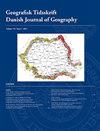Exploring the future of rural–urban connections in sub-Saharan Africa: modelling urban expansion and its impact on food production in the Addis Ababa region
IF 1.1
4区 社会学
Q4 ENVIRONMENTAL STUDIES
Geografisk Tidsskrift-Danish Journal of Geography
Pub Date : 2017-07-03
DOI:10.1080/00167223.2017.1350926
引用次数: 17
Abstract
Abstract The built-up area of Addis Ababa and its surrounding towns is expanding into the peri-urban region leading to high losses of farmland, directly influencing the food production for the urban population. This paper investigates the patterns of settlement growth in the region surrounding Addis Ababa and their impact on peri-urban agriculture using an urban spatial scenario design model. The effects of two population density scenarios are explored within the framework of a proposed master plan. The model output was used to estimate areas of different suitability levels that would be lost to the modelled settlement expansion. The settlement area in 2038 would represent 29% of the case study’s total area in the low-density scenario but only 19% in the high-density scenario. Compared to the low-density scenario, the high-density scenario would only require a third of the agricultural land transformed into settlement areas. Settlement development would contribute to higher losses of land suitable for cultivating important export products, high nutritional value and import-substituting products. The scenario approach can support sustainable regional planning for settlement expansion that conserves valuable farmland in the peri-urban area and contributes to building capacity for strategic planning of the city regions of sub-Saharan Africa.探索撒哈拉以南非洲城乡联系的未来:模拟亚的斯亚贝巴地区城市扩张及其对粮食生产的影响
亚的斯亚贝巴及其周边城镇的建成区正在向城郊地区扩张,导致农田大量流失,直接影响城市人口的粮食生产。本文利用城市空间情景设计模型研究了亚的斯亚贝巴周边地区的聚落增长模式及其对城郊农业的影响。在拟议的总体规划框架内探讨了两种人口密度情景的影响。利用模型的输出来估计不同适宜度的区域将因模型的聚落扩张而损失。在低密度情景下,2038年的定居点面积将占案例研究总面积的29%,而在高密度情景下,这一比例仅为19%。与低密度方案相比,高密度方案只需要将三分之一的农业用地转变为定居区。聚落的发展将造成适合种植重要出口产品、高营养价值和进口替代产品的土地的更大损失。情景方法可以支持可持续的住区扩展区域规划,从而保护城郊地区的宝贵农田,并有助于撒哈拉以南非洲城市区域战略规划的能力建设。
本文章由计算机程序翻译,如有差异,请以英文原文为准。
求助全文
约1分钟内获得全文
求助全文
来源期刊
CiteScore
5.20
自引率
0.00%
发文量
5
期刊介绍:
DJG is an interdisciplinary, international journal that publishes peer reviewed research articles on all aspects of geography. Coverage includes such topics as human geography, physical geography, human-environment interactions, Earth Observation, and Geographical Information Science. DJG also welcomes articles which address geographical perspectives of e.g. environmental studies, development studies, planning, landscape ecology and sustainability science. In addition to full-length papers, DJG publishes research notes. The journal has two annual issues. Authors from all parts of the world working within geography or related fields are invited to publish their research in the journal.

 求助内容:
求助内容: 应助结果提醒方式:
应助结果提醒方式:


